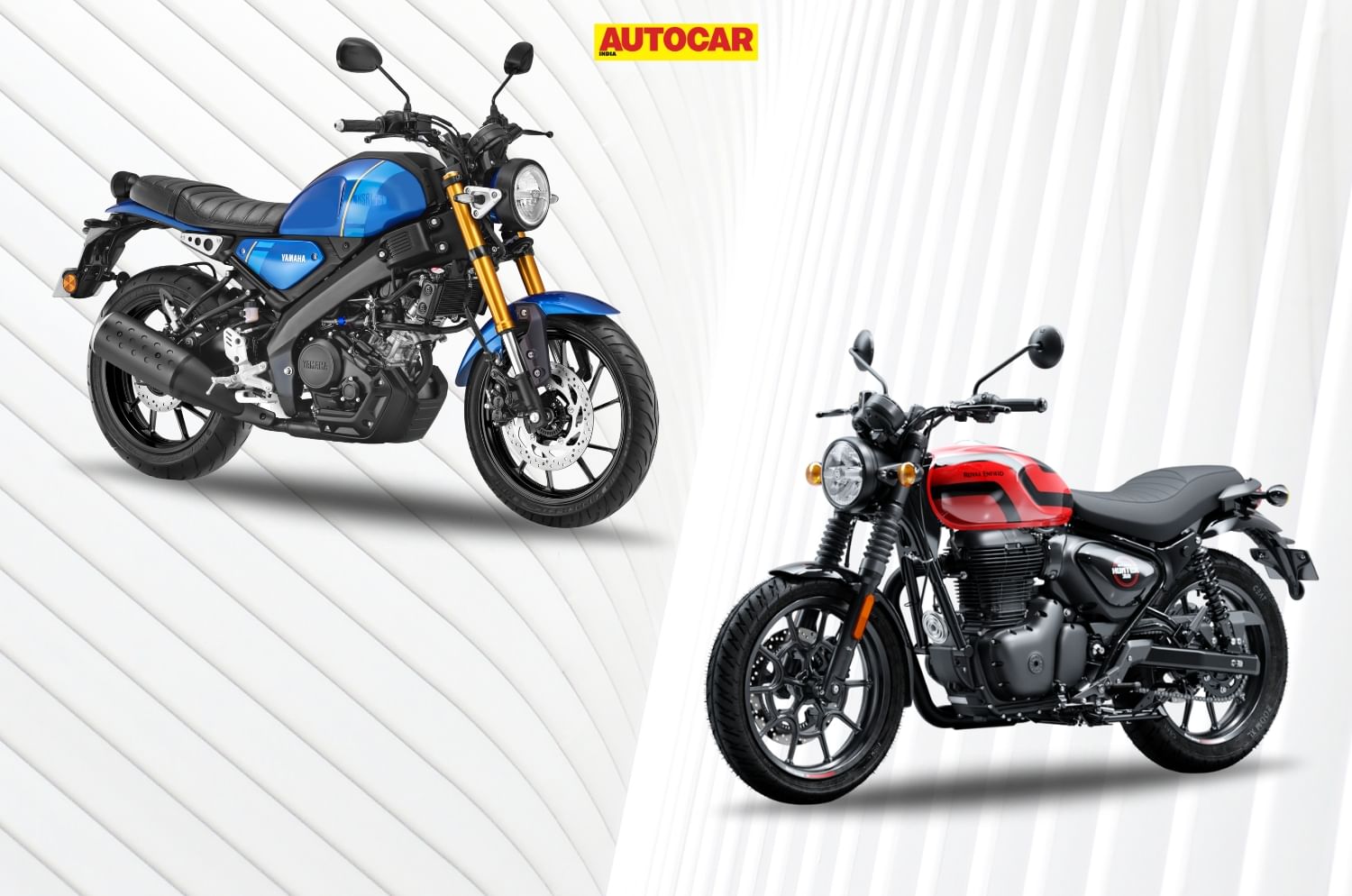
Yamaha has finally launched the XSR155 — the neo-retro sibling of the MT-15 — in India. It’s a roadster in intent and retro in aesthetic, putting it in line with the Royal Enfield Hunter 350. Here’s how the two stack up on paper.
Yamaha XSR155 vs Royal Enfield Hunter 350: Engine and output
The XSR gets a liquid-cooled, 155cc engine
| Engine and output | |||
|---|---|---|---|
| Yamaha XSR155 | Royal Enfield Hunter 350 | ||
| Engine | 155cc, single-cylinder, liquid-cooled | 349cc, single-cylinder, air-cooled | |
| Power | 18.2hp at 10,000rpm | 20.4hp at 6,100rpm | |
| Torque | 14.4Nm at 7,500rpm | 27Nm at 4,000rpm | |
| Gearbox | 6-speed | 5-speed | |
| Power-to-weight ratio | 132.8hp/tonne | 112.7hp/tonne | |
Both these engines are chalk and cheese — different in almost every possible way. The XSR155 borrows its sophisticated, liquid-cooled motor from the R15, a high-compression, free-revving unit that loves to chase the redline and will reward you for doing so. The Hunter 350, on the other hand, uses a traditional air-cooled, long-stroke engine that delivers strong low-end torque and a relaxed, unhurried performance.
Despite the XSR’s smaller displacement and lower torque figure, its rev-happy nature and taller gearing allow it to achieve a higher top speed. The Yamaha also benefits from an additional sixth gear, which the Hunter misses out on. Both motorcycles here get a slip-and-assist clutch.
Yamaha XSR155 vs Royal Enfield Hunter 350: Weight and dimensions
The XSR is over 40kg lighter than the Hunter
| Weight and dimensions | ||
|---|---|---|
| Yamaha XSR155 | Royal Enfield Hunter 350 | |
| Kerb weight | 137kg | 181kg |
| Fuel tank capacity | 10-litres | 13-litres |
| Wheelbase | 1325mm | 1370mm |
| Ground clearance | 120mm | 160mm |
| Seat height | 810mm | 790mm |
The XSR155 is over 40kg lighter than the Hunter 350 and even 4kg lighter than the MT-15. This difference comes down to the Hunter’s larger engine and its more traditional, steel-heavy chassis, while the XSR uses a Deltabox frame and an aluminium swingarm, which account for much of its weight advantage. The Yamaha also carries slightly less fuel, but its 155cc engine has proven to be efficient in our tests, so overall tank range shouldn’t be a concern.
Ground clearance appears low for the XSR on paper, but Yamaha has clarified that the clearance matches the MT-15 (170mm). The lower 120mm figure is the result of updated certification norms that use a different measurement method.
The Hunter’s seat height is marginally lower, which should help riders manage the bike more easily in the city, especially given its higher kerb weight.
Yamaha XSR155 vs Royal Enfield Hunter 350: Suspension, tyres and brakes
The XSR benefits from a radial rear-tyre
| Suspension, tyres and brakes | ||
|---|---|---|
| Yamaha XSR155 | Royal Enfield Hunter 350 | |
| Suspension (F/R) | USD fork / monoshock | Telescopic fork / twin-shock absorbers |
| Tyres (F/R) | 100/80-17 / 140/70R-17 | 110/70-17 / 140/70-17 |
| Brakes (F/R) | 282mm disc / 220mm disc | 300mm disc / 270mm disc |
The Yamaha uses a USD fork, while the Hunter gets a conventional telescopic setup – an on-paper advantage for the XSR, and one that also adds to its perceived value. In the Blue colour option, the XSR further highlights this with a gold-finished USD fork. At the rear, the contrast continues: the XSR runs a monoshock, whereas the Hunter uses twin shock absorbers. However, this isn’t necessarily a drawback for the Royal Enfield, as the brand addressed earlier concerns with the Hunter’s rear suspension and updated it this year, making it noticeably more pliant and comfortable.
Tyre sizes are broadly similar, though the XSR benefits from a radial rear tyre. On paper, the Hunter has larger discs at both ends, which is in line with its significantly higher kerb weight.
Yamaha XSR155 vs Royal Enfield Hunter 350: Features
Both motorcycles feature dual-channel ABS
The Hunter’s feature list remains fairly brief, with dual-channel ABS being its only safety aid. It does get Royal Enfield’s Tripper navigation pod for turn-by-turn directions, along with the familiar analogue-plus-digital dash shared with models like the Meteor 350 and Shotgun 650. The Hunter now also adopts the same LED headlight used across most of Royal Enfield’s lineup (barring the Bullet 350), along with an LED tail-light.
The XSR155’s equipment list is a bit more extensive. Dual-channel ABS is common to both, but the Yamaha adds traction control as an additional safety feature. It also gets a round LCD display with Bluetooth connectivity and comes equipped with all-LED lighting.
Yamaha XSR155 vs Royal Enfield Hunter 350: Price
The Hunter has a much lower starting price, but that base variant misses out on several essential features.
| Price | ||
|---|---|---|
| Yamaha XSR155 | Royal Enfield Hunter 350 | |
| Price (ex-showroom, Delhi) | Rs 1.50 lakh | Rs 1.38 – 1.67 lakh |
The Yamaha XSR155 slots neatly into the wide price spread that the Hunter 350 occupies. The XSR is offered in a single variant with four colour options, while the Hunter comes in three variants — Retro, Dapper and Rebel. The Retro is the base model with spoke rims, tubed tyres, a halogen headlight and a rear drum brake. The variants that line up more closely with the XSR are the Dapper and Rebel trims, which start at Rs 1.63 lakh. Against that benchmark, the XSR comes in at least Rs 12,000 lower.
Both motorcycles follow a similar neo-retro theme and share a comparable intent, yet their characteristics differ quite a bit. Ultimately, what suits you best will only become clear once you test-ride them and get a sense of how each one behaves.

